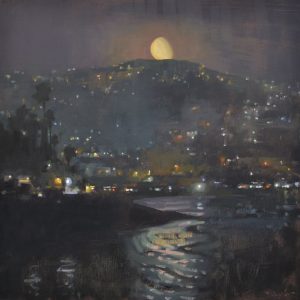 One of the great challenges for painters is a nocturne, a scene at night, or any scene in which the dominant light source is inside the frame.
One of the great challenges for painters is a nocturne, a scene at night, or any scene in which the dominant light source is inside the frame.
James Taylor sang…
“In my mind, I’m gone to Carolina
Can’t you see the sunshine?
Can’t you just feel the moonshine?
Ain’t it just like a friend of mine to hit me from behind
When I’m gone to Carolina in my mind?”
Yes, the light is a friend to hit you from behind. In most paintings, the light is from behind or to one side of the painter. When the light stares you in the face, you’re in for a fight.
You might say, “But artists paint sunsets all the time!” Yes, they do. Sunsets and sunrises are the “Golden Hour.” (No relation.) The window of time when the sun is low on the horizon, its light filtered and bent by our atmosphere.
But what about noon sunlight in the frame, streetlights, car headlights, flashlights, candles, campfires, fireplaces, fireworks, house fires, explosions? Transient vs. continuous light? A lamp vs. a flash?
Let me call attention again to Arkansas painter John Lasater. This painting, “Moon Hits Your Eye,” addresses the problem. Multiple, scattered pin pricks of artificial light, dispersed in the seaside haze, plus the waning gibbous moon, the “orb that rules the night, removing colors from our sight. (The Moody Blues)” Yes, it hits your eye. As does the sun when it’s in front of you, not behind. Blinding glare, reflections, refractions, mirrors. Not just of light, but of color.
The painter has to squint through the glare and choose what to see, what to translate to the surface of the painting. Tell the truth by ignoring what isn’t relevant.
All art is abstract, even photography. The author chooses what to include and what to omit.

